July 25, 2025
.png)
Note, transcription performed by AI and may contain minor mistakes.
[Tyler]
Good afternoon, everyone. Or depending on where you're at, it could still be morning, uh, if you're in the Central, Mountain, or Pacific Time Zones. But, uh, Ryan, it looks like we have a pretty good group so far. I know we're only one minute behind the hour here, but we have 17 folks joining us so far. So, thank you very much. Um, we got a lot of interest in this one, Ryan, so I'm excited to, uh, share more details. But for everyone who's already joined, um, I always like to ask, you know, please tell us where you're from. Uh, if you guys could hit the chat and see, uh, let us know where you're dialing in from today. I always get a kick out of, uh, what cities and states people are from. And then we'll get started here in a couple minutes.
[Tyler]
Oh, wow, we got a pretty good group today. Pretty, [laughs] pretty, uh, wide spread of folks coming in. So I see Mitchell Sutherland's calling in from Arlin, Texas. Good to see you, Mitchell. Ben from South Carolina. Ken from Syracuse. Calvin, I thought I recognized your name. Good to hear from you over in Traverse City. It's only about three and a half hours away from us. Uh, we actually have some people in our office today visiting from Traverse City, so that's great. Uh, Joseph Longway from Charlotte. Long time no talk, my friend. I hope you're doing well. Uh, I hope you get a lot of good value out of this. And Kathy, uh, I'm excited to see you next month at Thrive. So, uh, should be a good time.
[Tyler]
We'll give it one more minute for the folks, uh, still joining us here.
[Tyler]
And would someone humor me and just make sure that the, uh, Q&A is working if someone wants to submit, uh, a test Q&A, uh, question for us?
[Tyler]
Yep. Thank you, Mitchell, I got it. All right. Cool.
[Tyler]
All right. Awesome. Ryan, let's go ahead and give it one more minute. We'll start at 12:02 and we'll get, um, the party started.
[Tyler]
Awesome. Well, Ryan, I think we have critical mass.
[Tyler]
Got a good group joining us today, so we'll go ahead and get started. Good afternoon, everyone. Uh, my name is Tyler Hoffman. I'm the CEO and owner here at Metro Wireless. I'm joined today by Ryan Ortiz. He's our national channel manager. Uh, you may have gotten an email alert about Tom Benson leading today, but, uh, Tom's actually traveling into town for a trade show tomorrow. So we did a, a fun swap to a Jersey swap for Ryan Ortiz today. Uh, Ryan's also our, [laughs] our resident DAS expert, so it's a great opportunity for him to, uh, share some things about his experience, uh, helping, you know, partners and clients with their DAS, uh, deployments. And really, the reason we're here today is to kind of have a conversation about, um, you know, from concept to coverage, how to plan a DAS deployment. Uh, we get quote inquiries, um, you know, more than once a week, probably about, uh, three or four a week, I would say, about clients who wanna... or partners who wanna help their end users have a better cellular coverage experience indoors. And so, uh, who better than the, the national experts on the topic to, you know, kind of have a conversation on, you know, what does that project look like from, uh, from soup to nuts?
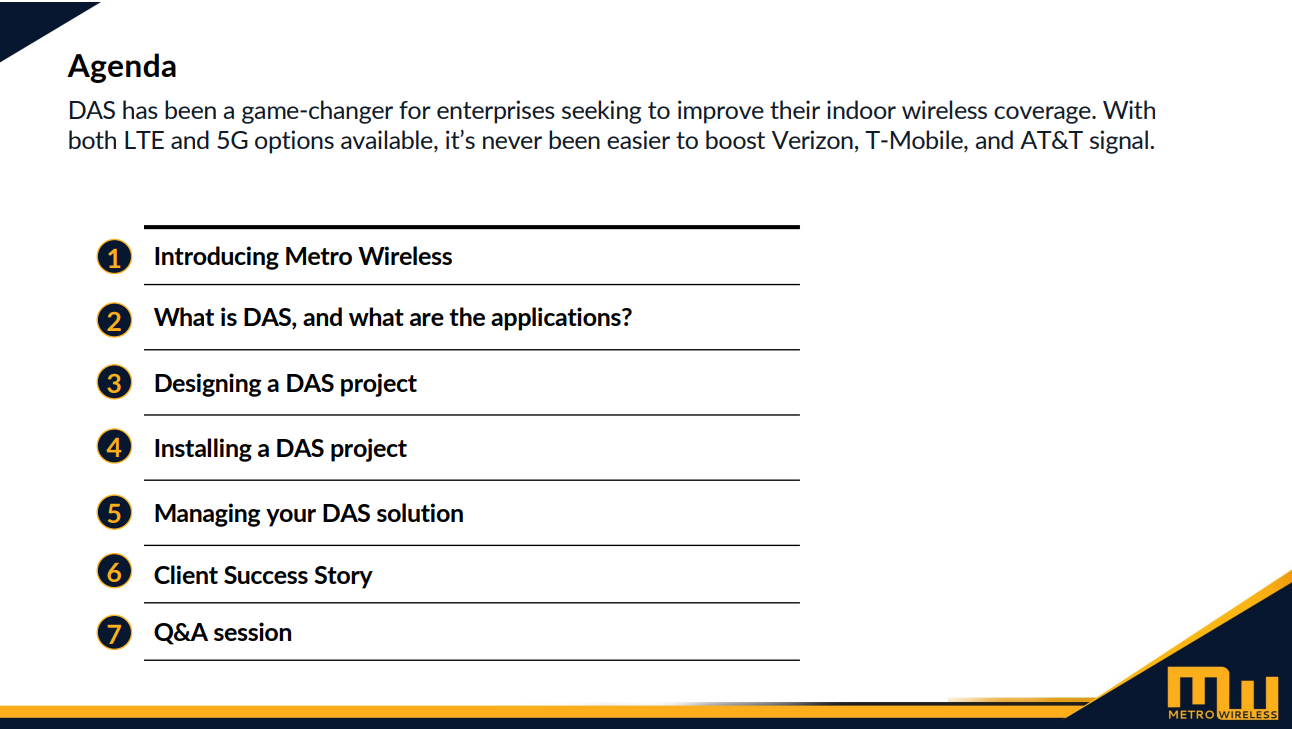
[Tyler]
We'll, um... there's a few parts of the dialogue today. Uh, and if, you know, hopefully everyone can see my screen. Please let me know if you can't. But we, we did test this to make sure it was, you know, working as expected. Um, but here what we have is, uh, we're gonna introduce ourselves and why we're the DAS experts. Uh, we won't pat ourselves on the back for too long. We'll dive right into it and talk about what is DAS and kind of what are the applications that we most often see, uh, from our, our partners and end users. And then we'll talk about the three phases of a DAS project. Uh, first and foremost, and probably one of the most important parts is the upfront design and consultation that we do as part of any DAS project. The second part is actually installing that DAS project and what it go- looks like from the rooftop to the, um, you know, end, end, uh, server node. Then finally, post installation, we'll talk about how we manage and monitor a DAS solution, just to make sure that for the life of the system, uh, you know, that everything's working and we have, uh, as I like to say, green lights, not red lights. Uh, finally, Ryan will take us through a client's s- success story of a oil and gas client that we did a recent installation for who's really excited about it. And, uh, we'll have a Q&A session th- for the last 15 to 20 minutes.
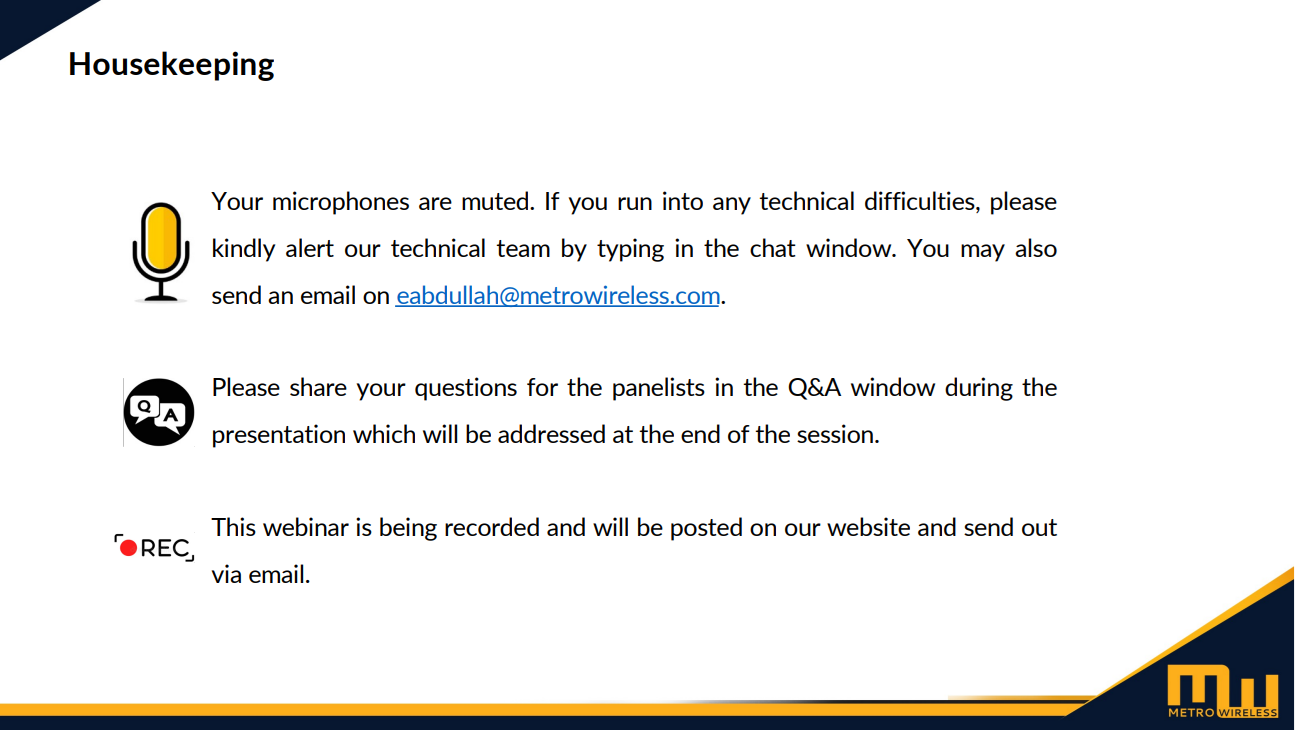
[Tyler]
Just some quick housekeeping before we get in, uh, to any further part of this. Uh, everyone's, um... oh, I'm gonna zoom into my slides a little bit. I can see that's m- someone mentioned that they're not as big as they should be. Is that a little bit better, uh, for you, Joseph?
[Tyler]
Um, a quick housekeeping item. So, microphones are muted by default. Uh, you do have that chat window as we're, we're all typing in where we're from today so we can see what's going on there. Um, please use the Q&A window. Uh, we know that's working. Uh, today. We're able to see, uh, all questions. We will save any answers for those questions until the end of the session. Uh, and also as a final reminder, this session is recorded. So we'll send out both the slides, uh... the recording as well as a transcription from the webinar, uh, after, uh, probably either later this week or early next week with all the details. So if one of your colleagues, you know, may find this content relevant or if someone couldn't join today, you know, please feel free to forward it on to them.
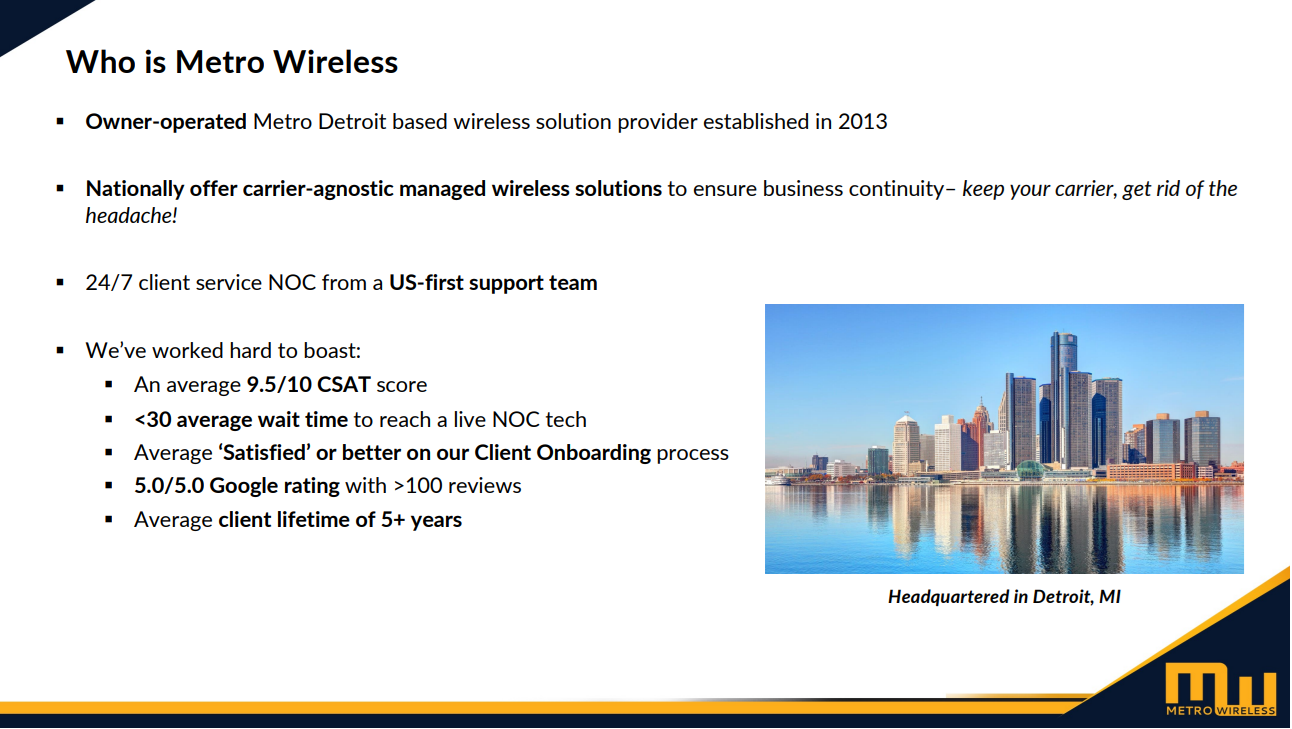
[Tyler]
But, uh, enough about that. I wanna quickly introduce who Metro Wireless is. Uh, you may know about us, 'cause you probably got this from an email list. Um, let me see.
[Tyler]
Um, I'm gonna zoom in just a little bit here if I can for you, Joseph. We'll see how that does.
[Tyler]
Margin should be mostly fine. Um, but we are Metro Wireless. We've been around more than a decade now, about 12 years. Uh, we are an owner operated solution provider. We're based out of Detroit. We're very proud of that. I'm dialing in from Detroit this morning. Uh, but really what we're known for nationally is providing a carrier agnostic solutions, uh, specifically in wireless, to ensure any type of business continuity. Uh, you may be aware of us, uh, just because we do a lot of LTE and 5G connectivity. We're an authorized Starlink partner, and, uh, we have our own fixed wireless network here in Detroit with microwaves and point to points and multipoint and things like that. What's cool about us is that we have a 24/7 NOC based here in Detroit. My team's all out here outside my office. Uh, and so we, we really pride ourselves on having good support. In fact, uh, we average 9.5 out of 10 in our customer satisfaction scores. Everyone gets a survey after a cert- support, uh, survey closes out. And so we, we really pride ourselves on good responses. Speaking of, we also average less than 30 second wait times to reach a live technician whenever you or your clients have to dial in. And we also average really highly on our, you know, customer onboarding experience, or project management as some people call it. Uh, we have really good Google reviews, and luckily most of our clients stay with us more than five years, which, um, you know, not everyone can say. So that's, that's really cool, and that's a testament to me, to Ryan and my whole team.
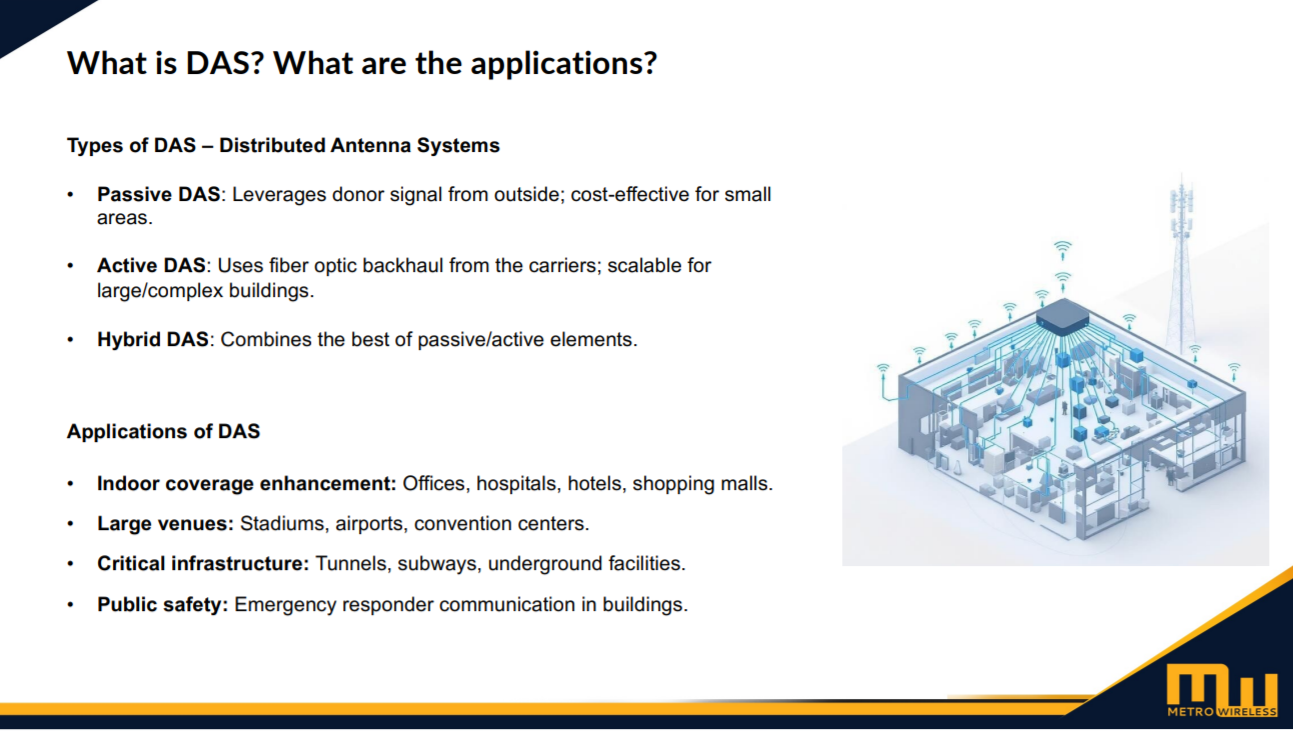
[Tyler]
But again, you know, what is DAS and what are the applications? So for us at Metro Wireless, a lot of people get, you know, reach out to us, you know, they don't necessarily know what DAS is, they just know they want better cellphone signal, and so we get routed the request to help out with the cellular coverage. So DAS stands for distributed antenna systems, and there's actually three types of, uh, distributed antenna systems. There's passive DAS, which is kind of the most, um, cost-effective option, pretty good for small businesses, uh, who need a good cost-effective solution. That leverages donor signal that grabs onto macro cellphone towers from the outside and then rebroadcast that signal in a pretty, um, simple way, I guess I'll call it, uh, inside the buildings. We typically see passive DAS in buildings up to 10,000 square feet, uh, or areas that just, you know, need a little bit of signal enhancement. It's a good option 'cause it's very cost effective, but it's a, it's a pretty simple system. On the other end of the spectrum, you have active DAS. Uh, active DAS is what you see at your local ballpark, um, sometimes in large hospitals, uh, other kind of, uh, very large facilities, ballparks, uh, football stadiums, things like that, concert arenas, um, things of that nature. Uh, because what it uses is a fiber optic backhaul that grabs onto Verizon signal, uh, T-Mobile, uh, and AT&T, and uses the fiber optics from those carriers to do that. Uh, what's really cool is it's definitely a very high quality system, but it's very expensive and time-intensive to deploy just because, uh, a user such as a hospital has to coordinate with all the carriers, uh, to get a system like that installed. And so it tends to be the, you know, by far the most expensive option.

[Tyler]
What's cool about hybrid DAS, and that's kind of the, the type of DAS that we specialize in at Metro Wireless, is it combines the best of both of those elements. Um, it's, it's much like a passive system where it doesn't require any carrier, uh, you know, coordination right up front. You don't have to talk to all three carriers specif- you know, independently, and, and kind of plan out the fiber deployment for those. Uh, but it's kind of a smart system in the sense that it's very, it's very digital based. It does, um, it boosts both LTE and 5G. It uses all carriers. It's pre-carrier certified. Um, there's very, there's a lot of channelization going on just to make sure that it boosts the best of each frequency and spectrum. And, uh, it's fast to deploy, much like a passive system. Uh, most installs, you know, once we, you know, receive deposit, get installed within four to six weeks.
[Tyler]
Now, what do we use DAS for? Well, we've, we've gotten requests for all types of facilities and buildings. Uh, mostly the time we're talking about office space, so, uh, you know, medium rises, high-rises, even, you know, these le- LEED certified buildings that Ryan will talk about in a minute here, all, all require good signal, you know, propagation, and sometimes they struggle with that. Uh, we're working on a number of requests for hospitals or other healthcare facilities. Uh, for some reason, assisted living is a very common, uh, request we're getting this year, and so we're doing a lot in the assisted living space. Uh, hotels and shopping malls are kind of the other big categories that we work with, uh, for that. Uh, active DAS really is a good use case for stadiums, airports and convention centers. Uh, sometimes they'll use hybrid DAS, but a lot of the times they're going for, for the active DAS solutions. Um, we also have gotten some requests for underground facilities. Uh, there's this large golf course that we've received a quote request for recently, uh, that needs help with, uh, an underground kind of maintenance area. And so we'll, we'll help them with that.
[Tyler]
The one thing I'll call out is public safety DAS is different than cellular DAS. Public safety DAS is intended for first responders. Uh, they have VHF or UHF radios that they need to, uh, make sure that they have good signal strength for indoors, especially if they're working in elevator shafts or in schools or things like that. Um, s- you know, public safety DAS uses very similar hardware to cellular DAS, but it's a completely different kind of deployment style, and it requires it to be certified. Uh, e- every deployment or installation has to be certified by the local authority having jurisdiction, or a AHJ as we say in the business. Um, so there's a lot of compliance that goes along with public safety DAS. You can't just use a cellular DAS to enhance public safety frequencies. There's different, uh, wireless frequencies that go on with that. So we won't focus on public safety today. That's kind of its own, you know, can of worms, if you will. Uh, we're just gonna focus on cellular today.So moving forward, Ryan, I would love for you to get into, um, you know, our... the way we approach DAS and our solution.
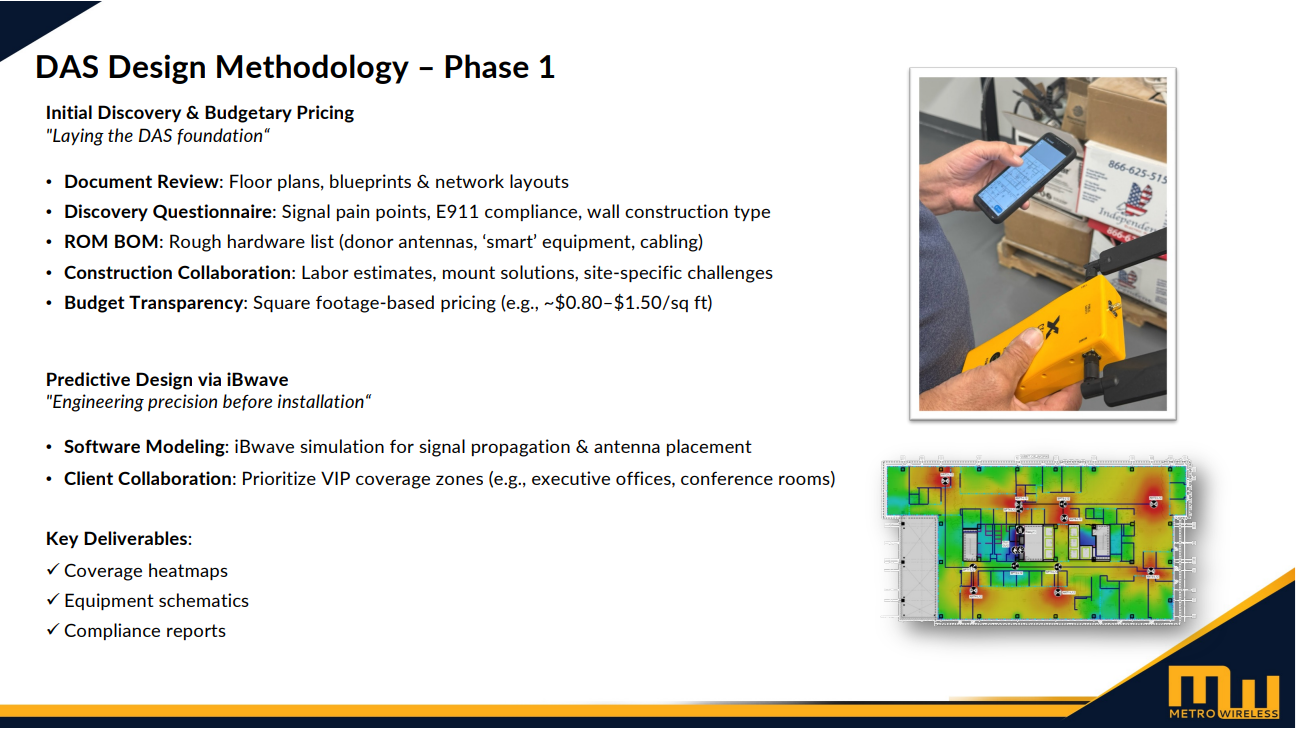
[Ryan]
Yes, thank you for that, Tyler. I appreciate it, and, uh, I think Kathy can attest that this is definitely the methodology that we actually follow on, on every single call that we have with her. Um, we talk about the idea that we are using a hybrid approach. There is a s- way that we do this. This is very systematic, because we're always looking at the address first to understand, number one, are we going to have a good signal to begin with that we can actually enhance? Um, if we're not able to do so, we're not able to proceed. So, we're always doing our best practices to understand what's going on to be able to approach that. The other thing that we're doing right off the bat is, we're making sure that we are relaying to the customer or the partner, number one, this is a hybrid solution. Number two, this is not going to take any special permits from these, from the carriers. And that this is carrier agnostic. So, this is not something that's going to only impact one specific carrier. This is gonna actually impact the signal on everybody. This is a great scenario, because the outcome is going to be measured by our construction manager. Based on the heat reports that they get, we're gonna be able to let you know what we can do and what we can remediate and what we can actually expect when we actually take care of things. And the only way to do this right is to actually come on site and actually see what's going on. We can't derive this information from, um, uh, from a, a map or a, a, a, you know, anything else that we get. We had to physically come on site, 'cause there's different materials that we're gonna run into, different unknowns, and we're only gonna know that when we get on site.
[Tyler]
Well said, Ryan. Well said. The, um... Yeah, there's three phases to any DAS project as we see it. Uh, Ryan, you wanna walk us through this, uh, this first phase here?
[Ryan]
Oh, guaranteed, guaranteed. So, our methodology is very important here. And again, we, we, ha- we run through this every single time like clockwork. So, the first thing they were always asking for is gonna be, we need to have an idea of the plans. We need to understand the square footage, the physical address. What's driving this? Is there a compliance measure? Is it C-level executives that say, "I just can't get a damn signal. Help me out." You know? What's going on here? We wanna make sure that we're understanding the situation and taking care of this, as well as the construction type. We're seeing a lot of buildings that are actually being constructed, uh, now with a, a lot of e-glass. And the e-glass, unfortunately, while it's actually really, really good, it's actually prohibiting the actual cellphone signal from coming in. So, as those issues are arising, this is becoming more prominent. And we can go through all the different specifics about this and figure out what it's gonna take and give you budgetary information.
[Tyler]
Yeah. Well said, well said. Um, and another part of our, kind of first phase of our design is understanding, you know, via predictive software, and I'll zoom into the, to the right here. Uh, folks who've worked in this business a while might know about iBwave or the competing tool called Ekahau. Uh, but what we have the ability to do is take f- client provided floor, floor plans and put them into the software. And from there, we can put antennas, uh, onto the floor plans and understand how is the signal gonna propagate and provide coverage throughout, right? So here, uh, you could see a few antennas we did for a, a, on a client install recently. Uh, to Ryan's point, we need to understand during that discovery questionnaire... You'll, you'll receive the questionnaire via, uh, email post-webinar. Uh, but we ask questions like, what is the wall construction, right? Are we talking concrete walls, open walls, drywall? You know, are the ceilings open or are they sealed off? Are they drop ceiling? Things like that. And from there, what the software does is it, it incorporates all those data points and spits out, kind of the predictive heat map, so we can understand where the coverage is, where the coverage is not going to be. Um, and so on and so forth. And so, you know, routinely, we'll hear from clients like, "Hey, we really care about having signal in executive offices and in conference rooms." And, "Hey, Tyler, you know, and Ryan, maybe we wanna save a little money and not focus on the stairwells and the restrooms." And so we're able to kind of customize that design solution to make sure that we're prioritizing the right areas. Um, some of the deliverables from this phase of the project that we'll provide to you and your client are coverage heat maps, those are the heat maps that you see in the bottom right. As well as the equipment schematics, uh, kind of laying out, you know, the riser diagrams of how the, the equipment and the cable paths and the antennas are all gonna go. Uh, and compliance reports, which are really more for us, but just to ensure that we're complying with the, the desire to, you know, boost signal both across LTE, 5G, Verizon, T-Mobile, AT&T. Wherever there needs to be a signal, we're complying with that design, so to speak.
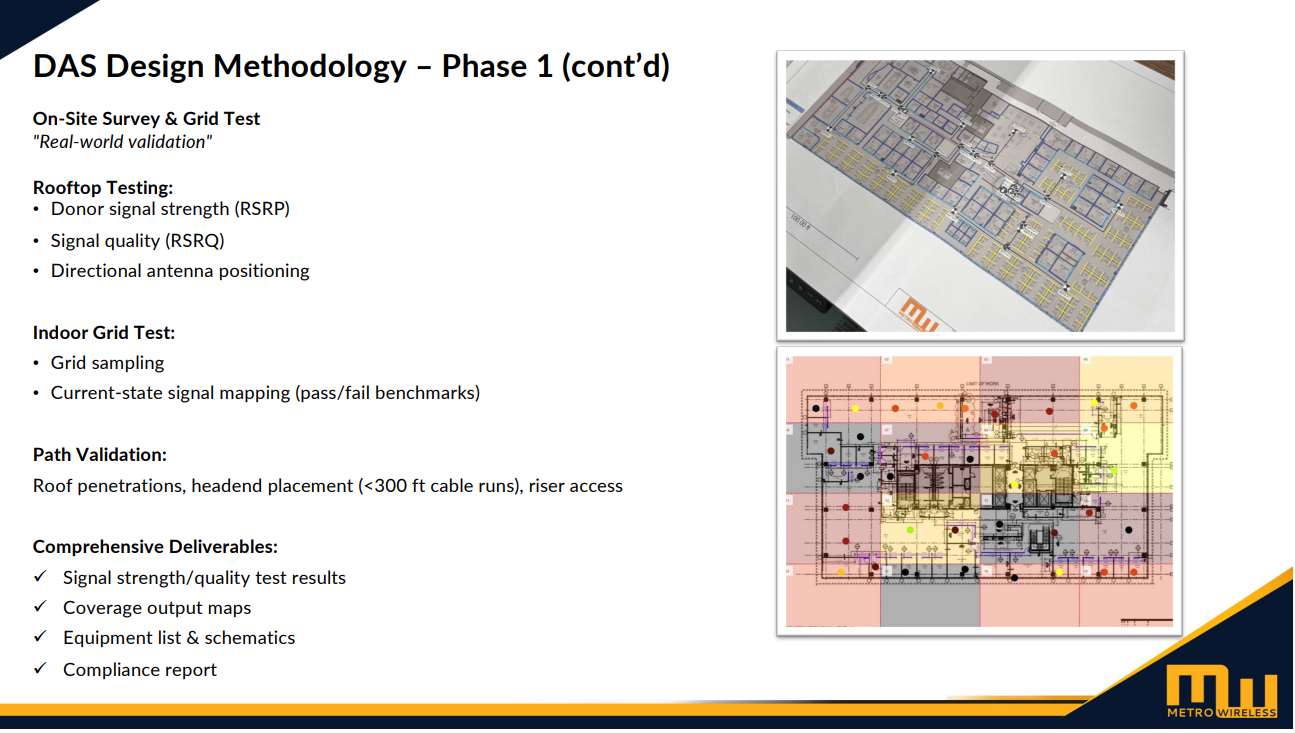
[Tyler]
Um, as part of that, what we're also doing on our onsite survey, that Ryan mentioned, is something called the gr- grid test. That's a real-world validation to understand, hey, uh, maybe you guys have some users that are complaining about p- poor cellphone signal indoors. Rather than just, you know, relying on hearsay, if you need to build the business case that you need to de- deploy a proper DAS solution, let's get our guy on site and perform a real world test. Um, so the first part of us going on site is a rooftop test. So really, one of my construction managers, he's a W2 guy, he wears the same polo I do, he's on my team.
[Tyler]
He goes on the rooftop of your facility and he's testing for two things. Signal strength, which is, you know, in, in layman's terms, how many bars of strength you have on your, your cellphone, per se. But he's also testing for signal quality. Uh, y- you know, and it's really good to have high signal quality, but if you don't have good signal... Sorry. It's, it's of course important to have signal strength, but if you don't have great signal quality, that's where you really need to ensure that you have enough, kind of minimum benchmark, so to speak. Otherwise, our systems can't work properly and it's kind of garbage in, garbage out.
[Tyler]
What we'll also, uh, ensure is that we can, you know, position the antennas as needed for the final installation. Uh, you'll see in, uh, the next photograph how we'll kind of position antennas three different ways. Uh, one, uh, one for each carrier, right? So, one antenna for Verizon, one for T-Mobile, one for AT&T. Uh, we'll confirm that during our onsite survey.The second part, you might've seen a photo from the earlier slide, I'll just flash it up again real quick, is the, uh, floor plan test. So you can see one of my construction managers here. He has a RF signal meter here. He's taking data points, uh, working with his cell phone here, and he's testing to say, "Hey, how are we doing from a current state benchmark analysis of signal strength inside the building?" So here's a sample of that report. Typically is, these reports are about 200 pages. Uh, they're, they're very detailed, but they help us understand the signal quality and the propagation statistics. And so here, he takes at least two data points in each part of your floor plan. Uh, typically, we do them about 1,600 square feet apart, so this one for example has one, two, three, four, uh, has 16, uh, plates on it, as you can see.
[Tyler]
And so here, uh, this, this s- specific floor plan for this specific carrier on either LTE or 5G, uh, failed most benchmarks, right? So you can see on the bottom right, you have a lot of red, which is showing you that, hey, we're not getting good signal strength or signal quality. Uh, but in the, kind of the top right, you know, the signal strength is a little bit better. Maybe it's near an exterior wall or window. Again, not a perfect test, but, you know, this data, this deliverable, so to speak, from the grid test allows us to understand, hey, what are the, what's the current state look like? How bad is the signal, you know, is it really? You know, maybe there's one carrier that's doing well. Maybe T-Mobile, for example, is doing well, but the other two carriers are not doing well, right? And so this grid test helps us understand, uh, just exactly how good or bad the signals is, and it helps clients build the business case that they need to, uh, you know, go ahead and get a proper DAS solution.
[Tyler]
The last part of it is, is path validation. It's, it's certainly not a sexy part of the, the project, but, uh, we need to confirm that all the cable pathways and the MDFs and the IDFs are in the right locations for us. Uh, so my construction manager will go into the IT closets. Uh, he'll take a look at where he needs to mount equipment. He'll make sure that there's accessible AC power. Uh, yes, our systems use AC power, and are actually not rack mountable. They're kinda like to have some breathing room, so we mount them on the wall, typically, uh, in your telco closet. And then from there, uh, once we finalize the design with the iBwave software, we'll provide to you all the grid test results. We'll provide you, uh, any final equipment list and kinda bill of materials that we're gonna have. We'll produce a final proposal that we'll walk you and your client through. And from there, uh, we have a pretty good understanding of what we're gonna need to do, uh, in order to, uh, provide your, you know, you guys, uh, good cell phone signal at that point.
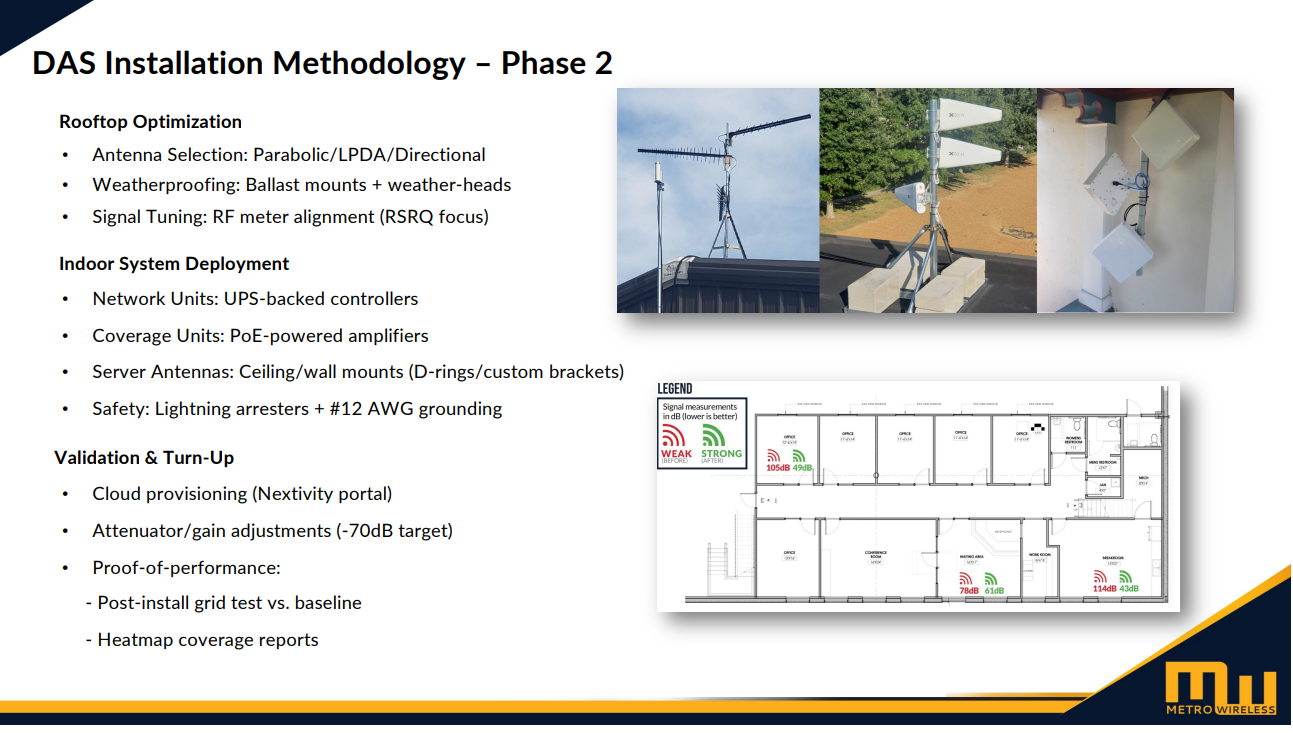
[Tyler]
The next part of this project is, of course, the installation. I mentioned those antennas in the top right there. I'll zoom in just so you can see those a little bit better. Uh, there's typically three types of antennas that we work with. Uh, directional antennas, those are the two first images on the left. Um, one's obviously i- a little bit smaller than the other. On the left-hand side, you have three. We call them LDPA antennas. They're about three feet big. Uh, way, they, they capture way more signal than your, your cell phone would ever capture signal outdoors. That's part of the donor, uh, signal that we, we lean onto, uh, from the carrier macro towers. Uh, in smaller environments where it's a smaller building or we're closer to the cell phone towers, so not, we're not worried about attaching to a good signal strength, we'll use kind of the middle option there. Those antennas are probably about a foot wide, if I had to guess. Um, those are a little bit smaller and easier to, to deploy. And then on the right-hand side, uh, this is a kind of a cool install. It was actually a, a, a wealthy residence in Fort Lauderdale, Florida. Uh, they, this client did not desire to have very large antennas, so we found kind of a smaller square option that worked well for his, uh, for his donor signal outside. So that's the first part of the installation is to make sure you capture onto really good donor signal. Uh, we typically install on the roof. We try to avoid rooftop penetrations, uh, just because no one, no client ever likes to have holes in their, in their rooftops. Uh, but when necessary, we'll work with their preferred roofing contractor to install a weather head. Uh, we've had to do that a couple times. It's, it's not a big deal, but, um, we will do that, uh, on your behalf so you don't have to worry about that. We'll also do some signal tuning at that point, too, just to make sure we have a good balance of signal strength, but also signal quality.
[Tyler]
And then from there, it's, it's very similar to a managed Wi-Fi job. Uh, we're installing, you know, network units and coverage units. Those provide signal to the, the Nextivity DAS system that we use. And then, um, we're installing the switches and the controllers in the, in the, in the telco closets or in the open kinda raceways in the ceilings. And then, uh, the last part of it, of course, is the server antennas. The server antennas are kind of like a Wi-Fi node, and so from there, we install those, um, you know, little bit less densely in the Wi-Fi node. Uh, but we install those either in the drop ceiling or the open ceiling, or, you know, on the sides of the warehouse, or however the, the installation is deemed to go. That's part of our process. I do want to call out that lightning arrestors and kinda grounding protection is super important. Uh, as you can imagine, we're, we're installing antennas on rooftops, which tend to act like lightning rods sometimes. And so a big part of our process is to do proper grounding, uh, in our systems. Uh, again, not something that's super sexy, but because we do it so often, we've learned the best practices for doing that kinda thing.
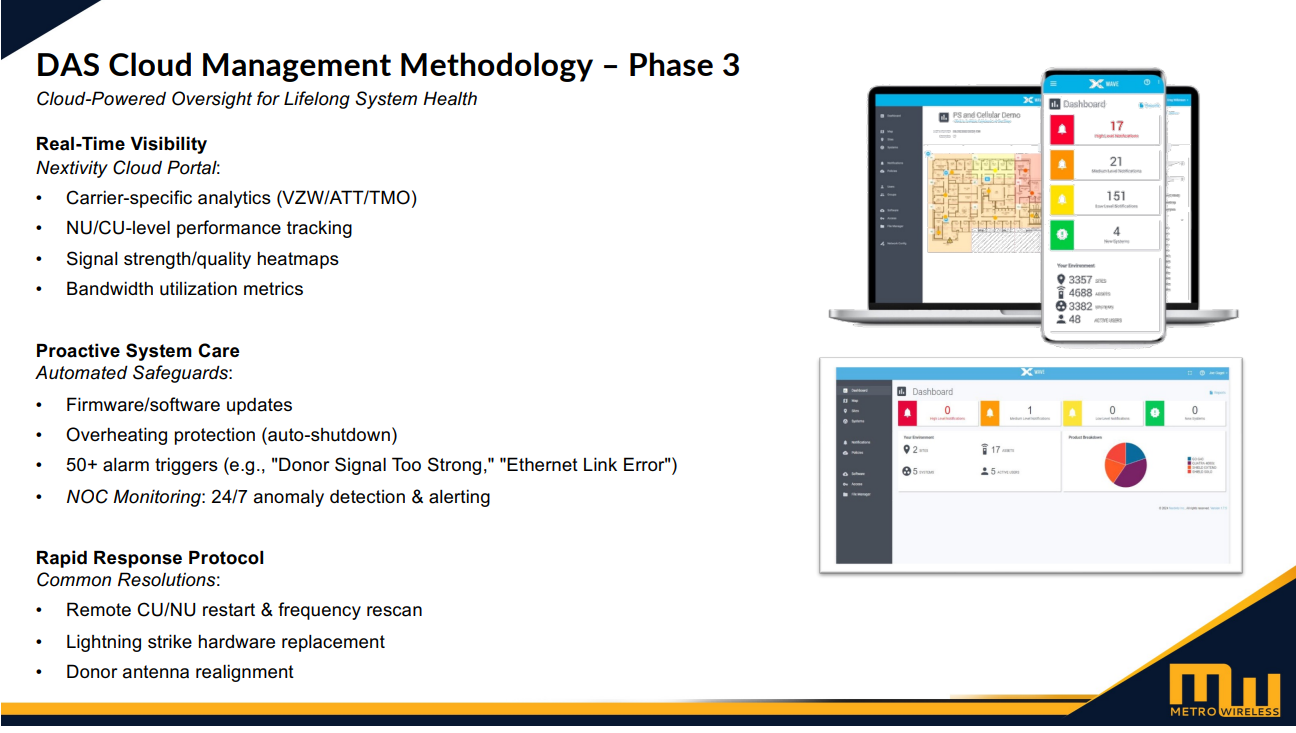
[Tyler]
At the end of our installation, uh, we go through the process of doing a cloud provisioning. So our systems are very intelligent. They're not like a traditional passive system. Uh, these hybrid systems use a cloud-based controller for not only provisioning, but for management and monitoring, which I'll get into in a moment. Uh, and so we log into the Nextivity Pro Portal. We do testing and turn up, making sure everything is good. Again, if we have any kind of fine tuning and signal attenuating and gain adjustments, we'll make those at this time, or my installers will. And then finally, uh, we like to prove our performance, right? I mean, most users immediately know when the system goes online because they see the full bars on their cell phone. Uh, we have many stories of very happy clients going up to our installers when they're installing a system and saying like, "Look, I never had s- you know, any signal before. Now we're really happy." Uh, which is always fun to hear, uh, post-installation 'cause I typically don't get to go to those. But, um, we do a proper grid test post-installation.And so this is just kind of an illustrative view. But the way that we run this is, uh, we take the same types of data points that we did from, uh, the pre-install process, and then we run through the whole process again. Uh, we can typically do a grid test of about 75,000 square feet per day. And we'll compare pre and post-install signal measurements, right? So we'll car- compare all three carriers, both on LTE and 5G, and we'll demonstrate to you and prove out to you and your clients that, hey, yes, we have the ability to, uh, prove that we improve cell phone signal across all carriers. Uh, you guys should be in good shape. And we'll never hide that data from you. That's part of one of the final, uh, deliverables that we'll do during our installation.
[Tyler]
Finally, uh, we get to the management side of it. So Metro Wireless doesn't just leave when, uh, we install the system. We're there with you for the life of the system. Uh, in fact, I was just on a site walk myself for a DAS system, uh, with, for Kathy, Kathy Weldon's team. Uh, it was, I think this was in May, if I recall. Maybe it was early June. Uh, but nonetheless, uh, we were in Boston, Massachusetts, and I was looking at a DAS system. Uh, the one we were replacing was nine years old, right? And so these systems, when installed properly, can last a very long time. Uh, the only reason we were looking to replace this system was that it was only LTE capable, and the client wanted something that was 5G capable. Uh, but nonetheless, I digress. What's really cool about our, uh, system is that we have the ability to, uh, use cloud-based management and monitoring to monitor your system for you. So as I mentioned, that same NOC team from Detroit, we have the ability to log into your system. We're very proactive, right? So I have details relating to, you know, carrier specifics. If the Verizon signal goes down, I know it. If the 4GT Mobile signal goes down, I know it. Um, down to the switch and controller level, we call them network units and coverage units. That's why you see the acronym there. We have the ability to understand what's going on with your system at any point in the system throughout, uh, its lifetime. We also take a look at how many people are on this, uh, you know, using the signal and things like that. Uh, bandwidth utilization, things of that nature. We also do all the software and firmware upgrades on your behalf, too, so that way, you never have to worry about that. Um, and there's lots of alarms and safeguards on these tools. So, uh, there's a client we had down in, I think it's in Athens, Georgia. It gets very hot there in the summer. Um, they have a warehouse. And so their system, uh, was, was reporting that it was overheating, and so we advised them to move one of their switches or coverage units into an area that had a little bit less, uh, temperature issues, and their system immediately improved once they, once they did that. But that's all to say, we have a ton of alarms and triggers and things like that. Uh, we're happy to set up clients so they can co-manage the system with us, but we find that most clients elect for us just to manage the system on their behalf and they don't have to deal with it. And so we're happy to do that, because our NOC team here is 24/7, 365, and all of my team has been, uh, trained up on how these tools work.
[Tyler]
Uh, of course, we can do other fun things like restarts of the system, reboots. Uh, occasionally that might have to happen, but not too often. Uh, we do help clients out. Uh, you know, I, I bring up the lightning strike example, just 'cause we had one recently. Uh, in the event that, uh, the system ever has an issue, we have a really strong relationship with the manufacturer and activity as well as our distributors. And so we're able to help facilitate, uh, quick replacements of any hardware that has any issues. Um, so we're, we're able to do that. And then on rare occasions, uh, uh, you know, a donor antenna on the rooftop might spin, uh, from a storm or something, we're able to help clients, uh, either remotely realign that or, uh, we can always do a, um, schedule a truck roll to have that realigned for you on your behalf.
[Tyler]
Ryan, I'd love for you to tell us about, uh, your success story that you had recently.
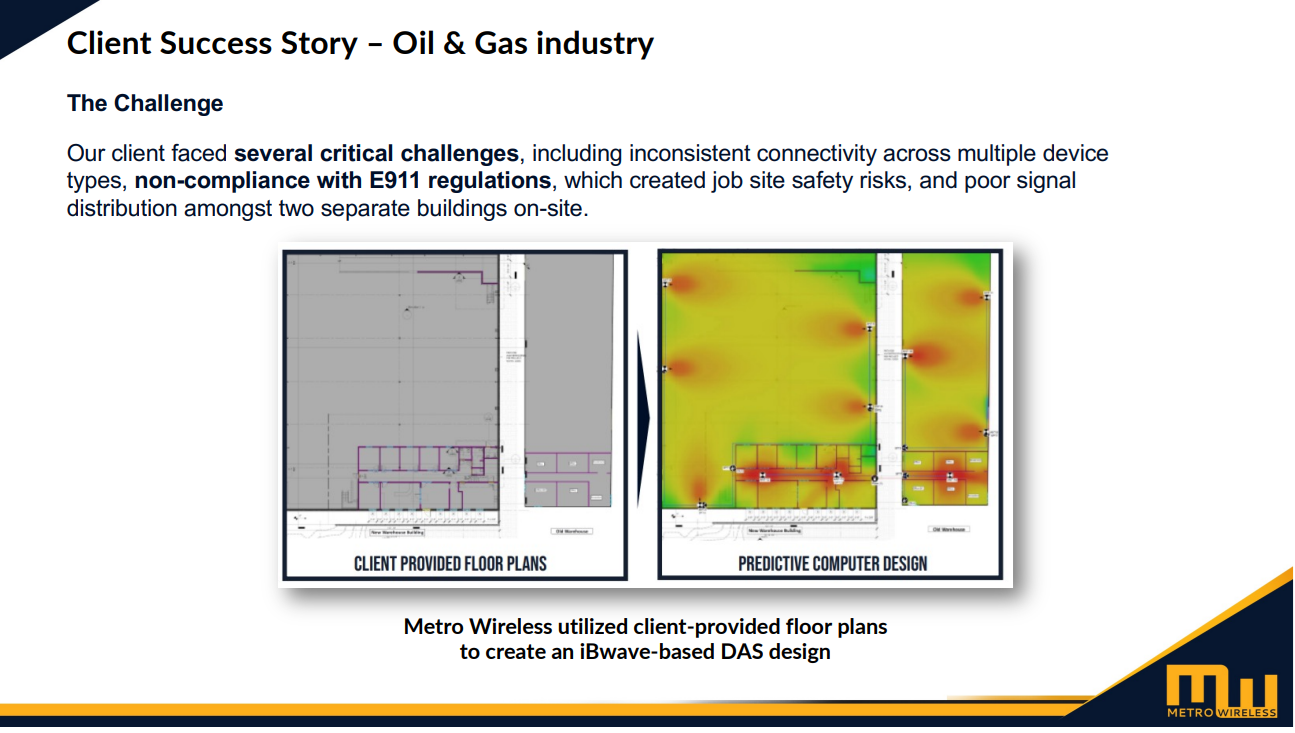
[Ryan]
Oh, thank you so much for that. I appreciate it. You know, it's, it's interesting. We get a lot of requests for help. Um, it's nice that we're seeing a lot more requests from the oil and gas industry, because I think it's, there's a lot of E911 regulations that are coming into play, where they're really needing assistance because of the safety risks that are inherent with the oil and gas industry. Um, one of the things that we're seeing is that the buildings that are being produced, like I mentioned earlier today, are actually ha- utilizing E, high E glass, um, technology, which means while it's good for energy efficiency, it's actually blocking that cell phone signal from penetrating into the building. And because of that, they're crumbling into more issues, uh, to actually meet those compliance measures. So with everything that we're doing, with our predictive mapping and everything that we're, we're working with, and using our best practices, our hybrid approach for DAS is working well for customers to have successful op- implementations.
[Tyler]
Yep.
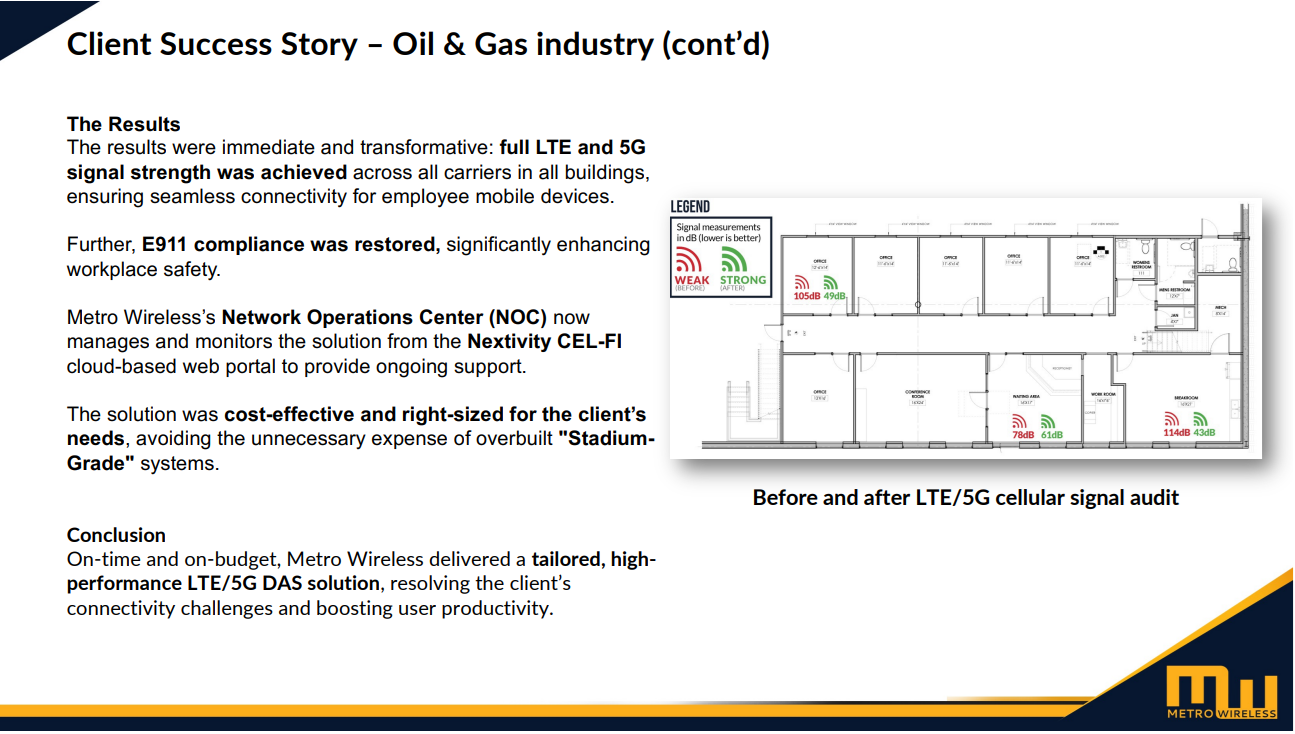
[Ryan]
And see, this is actually what it comes down to. The results with doing this and using hybrid is an immediate transformative situation for LTE and 5G. You're literally able to turn that around in roughly six weeks. You're not having to wait for permits. You're not having to go to the carriers. It really creates a nice workflow, and you get things done really quickly. What we are also seeing as well, is companies are literally coming to us saying, "We're looking at a property. We need to do an assessment before we move in to see if this is even gonna work for us." And we ve- have been asked on occasion to do an assessment before they move in to understand what they're getting themselves into. And to do that is part of their best practices so they can have that on file, so that when they move in, they know exactly what they're gonna need in the future, um, as other problems arise once they move on site. So a lot of this is becoming not only best practices, but just literally need to check the box for everybody that's doing this. Um, again, as Tyler alluded to earlier, our network operations center is 24/7, it's Michigan-based, and it's remote. So anything that does pop up, we can definitely restore any issues that arise or be proactive versus reactive to make sure nothing is going on in their facilities.And this is very cost-effective. That's the bottom line. This is why our customers are coming to us, because this is a lot more cost-effective than going to the carrier, having to spend lots of money to get things looked at, um, having to pull permits, i- i- so much time. At the end of the day, six weeks later, we can get these things done. The customers are happy. They've reduced their issues. They have everything they need, and they're boosting their user productivity. So, it- it's a win-win all the way around for everybody involved.
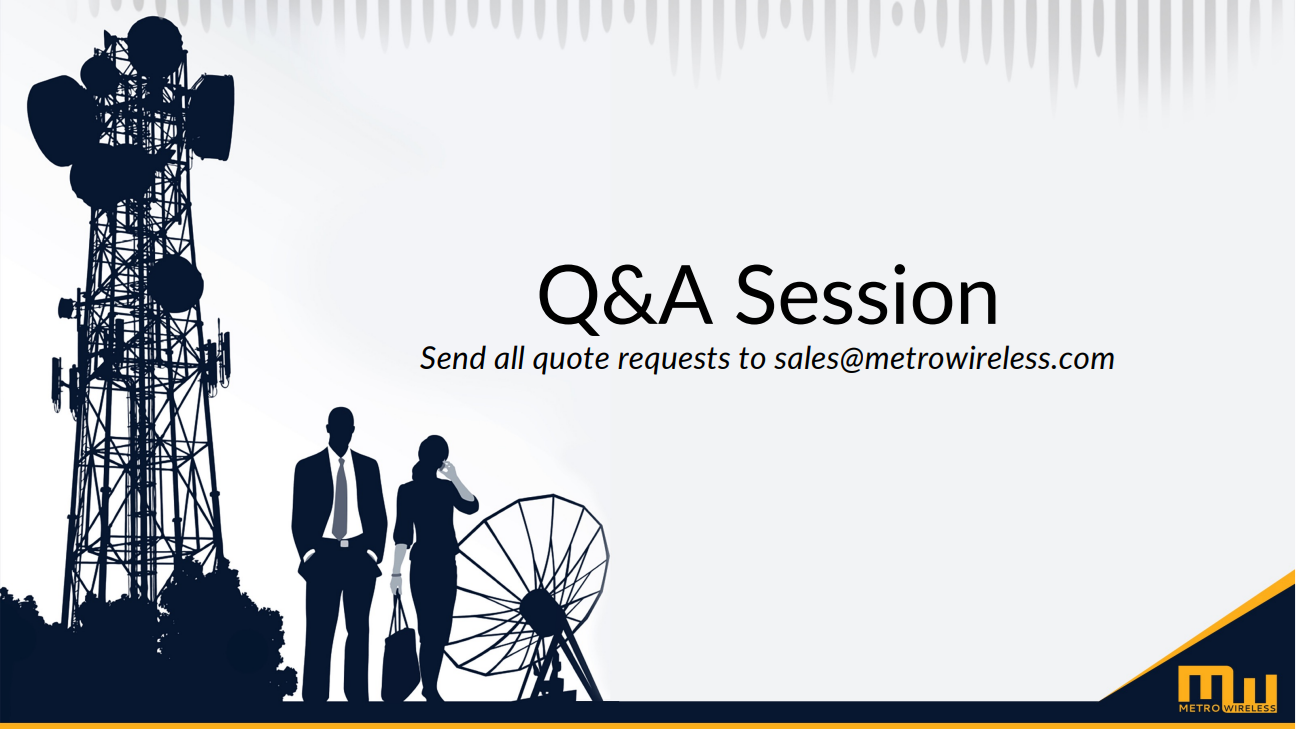
[Tyler]
Well said, Ryan. Thank you very much. Um, team, we're at a point now, we're about 30 minutes through the presentation. We wanna leave it open for a Q&A session. Um, as I mentioned to you before, we will, of course, send out the slides and any marketing materials along with DAS, say our DAS flyer, our discovery questionnaire, a case study that Ryan just had walked you through. Um, but now is your time to ask us any questions. Uh, we have certainly got all the questions from years of doing DAS, uh, from our, our clients and partners, but, uh, please go ahead and use the Q&A section or put them directly into the chat to, uh, help us, uh, answer any questions you have. Thank you.
[Tyler]
And Ryan, I tell you what, while we're waiting for any questions to come in, I'm gonna answer, um, uh, I think there was one part of this that I wanted to walk through a little bit more closer for us. And so, um, the way our DAS system works, especially for people who have never done this, just because Ryan I love this chart, um, is all of our systems rely on donor signals. Again, those are outdoor antennas that we install to capture the, uh, cellular coverage from cell phone towers, we say up to nine miles away, but Ryan, you and I both know that we've done installs up to 12 miles away, uh, without any issues. From there, we route that, uh, s- donor signal down to the MDF, and we have a distribution system, it's called a network unit, or we'll call it like a controller, if you will, if you're familiar with like Wi-Fi, of course. Um, and so from there, what that distribution system does is combine all three carrier signals, uh, together, both AT&T, Verizon, and T-Mobile, uh, both LTE and 5G. And from there, you have one consolidated digital, really high-quality signal that you can then use for redistribution throughout the site. Uh, as I mentioned, of course, and Ryan you did too, the signal is pre-carrier approved, which reduces all that timeline for installation, which, uh, people really like. And then from there, we have it, uh, we wire it out to the server antennas. It's very similar to how we are going to have, uh, the, uh, a Wi-Fi placement. It's a little bit less dense just because cellular signal propagates better than Wi-Fi. Uh, but those server antennas are then, uh, used to redistribute the combined outdoor cell phone coverage, uh, you know, r- ensuring that you have good signal strength everywhere indoors. And so again, that's just a little walkthrough. We use this diagram a lot. Uh, people find it very helpful, uh, in understanding how a hybrid, you know, DAS system so- works.
[Tyler]
Ryan, I see you've got some questions in, so I wanna make sure we get some of these answered. Uh, yes, to answer the question, uh, the system does boost both 4G and 5G and all the relevant bands. Band 71 is a big one. Band 41 is another big frequency in the 5G spectrum, and it does go back to all the LTE bands as well. Uh, clients really like to use our system because it works really well for SMS two-factor authentication, which, of course, are those little text messages that you get when you try to log into certain applications. Um, and so that's, you know, helpful. Uh, another question we often get, and this is asked today too, is, you know, it seemed like carriers used to do this for free. Do they, do they still? And, uh, unfortunately, the answer is no in most cases. Unless you're Comerica Park, as I like to say, the big ball stadiums here in, in Michigan or wherever you're at, uh, most, you know, tenants of buildings cannot get a carrier to install a DAS system. They're just frankly too expensive to get good coverage area, uh, everywhere, and so on. Uh, and so they, they typically don't install for free, and so it is a cost. Now, what we will s- see a lot of the times is landlords will be able to cover the cost for their tenants. So if you, uh, lease your building or your space, uh, you can typically ask your landlord to see if they'll help offset or subsidize that cost.
[Tyler]
Uh, one thing I also want to hit on too, and I see it's a question here, is, uh, as far as the, you know, costing rule of thumb for a deployment, it, it really varies, right? And so typically we like to say 80 cents to $1.50 a foot. Obviously, that's a big range from a square foot perspective. Uh, smaller deployments are always the most expensive per foot because there are certain infrastructure costs that are kind of startup costs, uh, that you need to get in order to get a good system in place. Uh, but once you expand, there are good economies of scale. Uh, for example, I recently did a 10,000-square-foot job, and I think it was about $25,000. So even beyond the $1.50 a foot. And then I think we quoted a 600,000-square-foot assisted living facility recently, and I think we came in at about 80 cents a square foot. So it just depends on the, the type of structure. Other things like time of day installation. So hospitals often, uh, require overnight installation. That'll add to the cost. If we're working with concrete walls, that'll be a difference too, things of that nature. And, uh, Mike Schuter asked, good t- good to see, f- uh, see and hear from you. We, uh, we do... Michael has a question here, "What are the typical payment requirements such as 50% down and remainder due on install?" Uh, yeah, so that's typically the case for us and for most integrators like ourselves. We require 50% up front as a deposit for the system. That pays for our parts, pays for our labor, and things like that. And then upon final installation, once we hand over that final grid test, uh, proving to you that we have boosted signal effectively, uh, at that point, we will, uh, collect the remaining 50%. And then we'll also start billing for that monthly recurring management and monitoring support service that we have discussed. So, and that's typically how we handle that. Thank you, Mike. Um, Kathy, you had a good question for us on the difference between DAS and a private cellular network. Um, very interestingly, we're getting a lot of requests recently for private cellular networks. Uh, what's interesting about the Nextivity system that we typically use is that we do have the ability, uh, to turn a cellular DAS into a private cellular network.... the thing of the nature is, and really we're seeing this a lot with, um, you know, comparing wifi against private cellular, is, you know, cellular networks have always been intended to be used for handing off, uh, from tower to tower, from access point to access point. Wifi just doesn't have the good propagation, uh, and the characteristics of its signal type to hand off, uh, from AP to AP. Uh, but cell phone signal does, and so that's a really good, um, you know, thing for us, and that's where we're starting to see private cellular come to be a factor, is clients who don't want to rely on wifi because there's too much interference. Uh, it's not roaming well from access point to access point. So if you think of a warehouse, for example, and there's a forklift... I was just in LA actually with a construction manager on a site walk. Uh, they had a private cellular network, and what they were using it for is their forklifts have these barcode scanners on them, and they can't rely on wifi because if they're going from one part of this 100,000 square foot warehouse to the other part, the signal scanner can't rely on a wifi signal well enough to be able to s- you know, scan each pallet as it goes by. And so they'll use a private cellular network for that. Uh, we're working on another private cellular network for a big airline, uh, simply because they can't rely on the public cellular network to provide good signal at an airport. Um, I ve- I often have issues with cell phone signal at airports, uh, just due to, like, the FAA requirements or what have you. And so we're working with a large, uh, airline to provide them a private cellular network as well. Other than that, uh, Kathy, the only difference between a cellular DAS and, and a PCN, as we call it, uh, is just the fact that one, you know, is privatized and very secure. Private cellular is, it's an encrypted network. And, uh, whereas cellular DAS is obviously just riding on the, the carrier signals from Verizon, T-Mobile and AT&T. So, um, the main differences are there.
[Tyler]
I don't think we... Ryan, are we seeing any other questions? I think we're, we're at a point now-
[Tyler]
... we're, um, doing, uh, doing well. But I want to thank everyone for joining today, uh, and appreciate you guys taking the time with us. I, I know, uh, everyone's very busy and so we really appreciate it. Uh, if you have any inquiries on this solution, whether it's for yourself or your clients, you know, please, uh, email us at sales@metrowireless.com. I'm gonna be sending out all of these slides. We're gonna be sending out the recording of the webinar, the transcription from the webinar, as well as our marketing materials in the coming days. And my sales team, Ryan and Tom Benson [smacks lips] will reach out to you, uh, just to make sure we're in a, we're in a good place. So, um, thank you so much. We really appreciate your support. Uh, we continue to get a ton of momentum, not only in DAS, but in Starlink 5G, uh, private cellular networks, wifi. So, we'll, uh, we'll continue to go, go to bat for you. Thank you.
